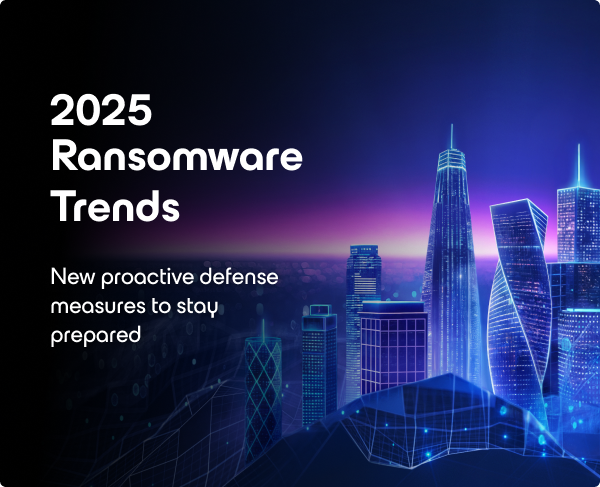
Online Registration Launch
- Data Security
- Ransomware Recovery
Ransomware Readiness Starts With Recovery You Can Trust

- Ransomware Recovery
- Overview
- Veeam’s Approach to Ransomware
- Capabilities
- Veeam Portfolio
- Latest Trends & Insights
Cyber Extortion is Growing and Evolving
Backup is Easy, Recovery is Hard
Veeam’s Approach to Ransomware
Protect
Ensure your data is immutable, air-gapped, and isolated, so it stays protected from ransomware attacks and is always ready for a clean recovery.
Detect
Detect malicious activity early by integrating with security tools and surfacing anomalies so you can respond before the damage is done.
Recover
Enable fast, clean recovery with verified backups and orchestrated restores, so you can bring systems back online without risking reinfection.
Built for every stage of a ransomware attack, Veeam helps you protect, detect, and recover quickly and confidently
Immutable and Isolated Backups
Keep recovery data safe with native immutability and air-gapped copies, so even if ransomware gets in, your backups stay untouchable.
Inline Scanning
Provides real-time threat detection during backup with AI-driven analysis of suspicious file changes, encryption patterns, and malware artifacts like ransom notes.
Recon Scanner
Proactively maps suspicious activity in Veeam environments to over 400 MITRE ATT&CK tactics and techniques, helping identify threats early and guide faster response.
Veeam Threat Hunter
Delivers best-in-class, AI-powered malware detection with built-in, real-time protection against millions of known threats—continuously updated to keep pace with evolving attacks.
IOC Tools Scanner
Identifies known hacker tools and dual-use system utilities—flagging them early using MITRE ATT&CK intel to help prevent data exfiltration before it starts.
SOC Tool Integrations
Extend security visibility with integrations into industry-leading SOC Tools to enhance threat detection, response, and automation.
Veeam Clean Rooms
Validates backups in isolated, malware-free environments using automated testing and network isolation, powered by Veeam DataLabs, SureBackup, and SecureRestore.
Orchestrated Recovery
Streamline recovery with documented playbooks, testing, and automation, ensuring you recover quickly and cleanly after an attack.
Veeam Intelligence
An AI-powered assistant that provides in-product guidance on features, recovery workflows, and security best practices, helping teams act quickly and confidently during cyber incidents.
Secure Backups are Critical to Your Cyber Resiliency
Move forward with confidence - before, during, and after a ransomware attack.

Veeam is Purpose-Built for Powering Data Resilience
cyber extortion, negotiate with confidence, and recover quickly from cyberattacks.
Data Protection Starts With Trust
Data security is foundational to our approach.
We ensure that everything you do with us is safe and secure so you can focus on what you do best: keeping your business running.
Let’s turn your goal into a win
Veeam is More Than Backup
Than Backup
It’s Data Portability
Portability across hypervisors, clouds, and workloads for complete control of your data's destination.
It’s Secure Cloud Storage
Immutable, secure, and affordable, fully managed Zero Trust storage out of the box.
It’s Hybrid Cloud
Enterprise-grade reliability and speed on-premises, public cloud, and anywhere in between.
Know the Latest Ransomware Trends

2025 Risk to Resilience Report
We surveyed 1,300 organizations, with 900 experiencing at least one ransomware attack in the past 12 months. Here’s what we found.
Insights & Research for CXOs
Discover proven strategies to strengthen resilience and prepare for today's cyberthreats
Comprehensive Malware Detection Blog
Multi-layered malware detection catches threats before, during, and after backups—helping you recover faster and stay resilient against cyberattacks.
Building a Cyber-Resilient Data Recovery Strategy
Build stronger cyber resilience through Veeam Data Platform and the NIST Cyber Security Framework 2.0.
The Forrester Wave™
Veeam has been named a Leader in The Forrester Wave™: Data Resilience Solutions, Q4 2024 report.
FAQs
How does Veeam help protect against ransomware attacks?
Can Veeam detect ransomware?
Yes. Veeam offers the best threat detection in the market, it includes multiple threat detection layers such as inline scanning, Recon Scanner, and IoC Tools Scanner to identify suspicious behavior, known attacker tools, and ransomware signatures helping teams detect threats early and respond faster.
- Proactive Threat Assessment: Recon Scanner evaluates data on Veeam environments and detects suspicious activity mapped to adversary tactics, techniques, and procedures (TTPs) to prevent cyberattacks.
- Malware Detection: Best in class AI-powered signature-based, built-in malware detection offering protection against millions of malware strains.
- Inline Detection: Threat detection during the backup with inline entropy analysis and also file system activity analysis based on guest index data scan.
- IoC (indicators of Compromise) Tools Scanner: Identifies hacker tools that are utilized by threat actors and notifies before impact.
What happens if my backups are infected?
Can Veeam help during a live ransomware attack?
Does Veeam integrate with my existing security tools?
During a ransomware attack what makes Veeam different from other data resilience platform vendors?
How does Veeam support compliance and audit readiness?
Radical Resilience is Our Difference
hybrid cloud and the confidence you need for long-term success.
Ransomware Recovery Guide
Get the official guide on ransomware recovery for best practices.
Request Custom Demo
Oops! Something went wrong.
Please, try again later.
Contact us
Oops! Something went wrong.
Please, try again later.
